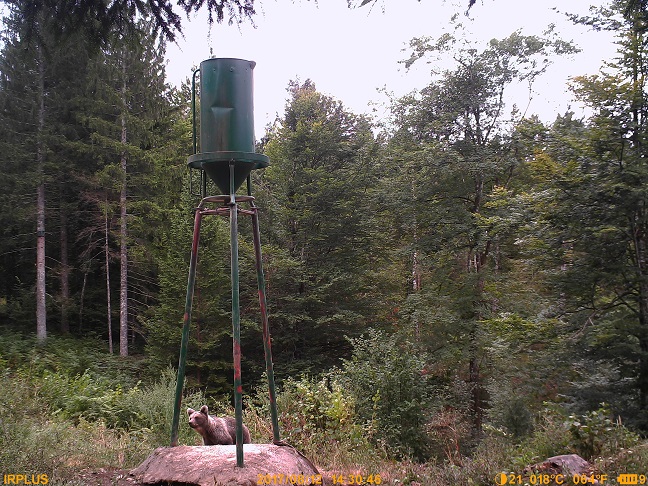Systematic bear counting on a network of permanent counting sites (feeding sites) is the oldest brown bear monitoring method in Slovenia aside from mortality recordings. In its present form it was introduced in 2004, but its beginnings date back to the early 1990s. The monitoring method has significant potential and in this report we provide the first ever assessment of how reliably it can be used to monitor a variety of indicators.
Analysis of all data collected until the end of 2018 has provided these main conclusions:
(i) Relative natality (i.e. share of cubs among all bears) of the Slovenian population is approximately 24%, which roughly corresponds to the results of other methods and to the values in other populations in Europe;
(ii) Females with cubs (both 0+ and 1+ cubs) account for roughly a fifth of the entire population, their share among all animals observed at the feeding sites remaining constant regardless of season, year or beech mast;
(iii) Bear litters average 1.9 cubs in the first year (age 0+) and decrease to 1.7 in the second year (when cubs are 1-2 years old);
(iv) The monitoring data provides a fairly accurate insight into local bear densities in the country and density dynamics;
(v) The number of counted bears is significantly affected not just by bear density but also by a beech mast, whose impact is noted in autumn counting but not in spring. In years with strong beech mast, up to 40% lower bear numbers can be observed on counting sites than in years when beech mast is poor or absent;
(vi) The monitoring data coincides well with the population size dynamics in the country, calculated by other modelling methods, and is therefore useful for monitoring population dynamics; data from spring counting, adjusted for precipitation on counting day, explains 91% of the inter-annual variability of population size.
Based on the results of the analyses and the identified strengths and weaknesses of using the monitoring data for assessing the above-mentioned parameters/processes, we believe it makes sense to continue using this monitoring method in future, but slightly adjusted: the second autumn counting can be eliminated, because it is less informative. The report also provides instructions for optimisation of data analyses (best accuracy of results) for each target parameter/process, and guidelines in case if separate counting sites are eliminated, changed or translocated.












